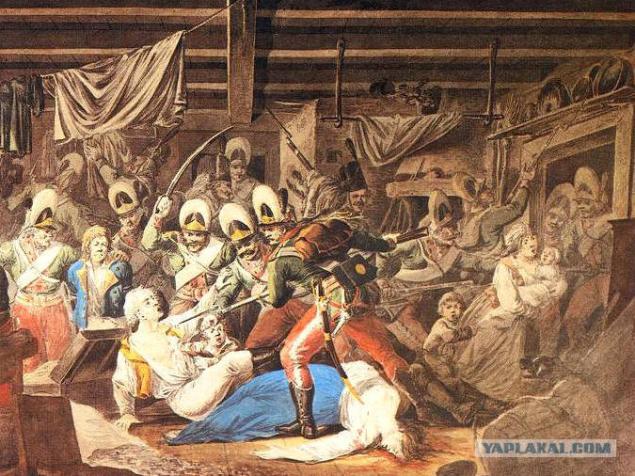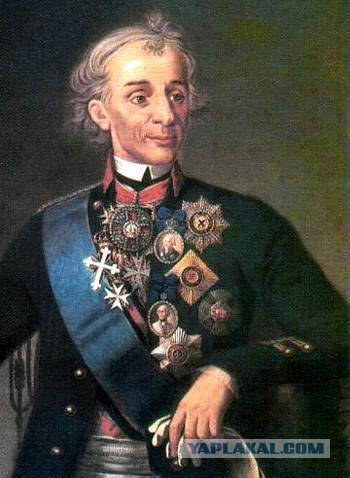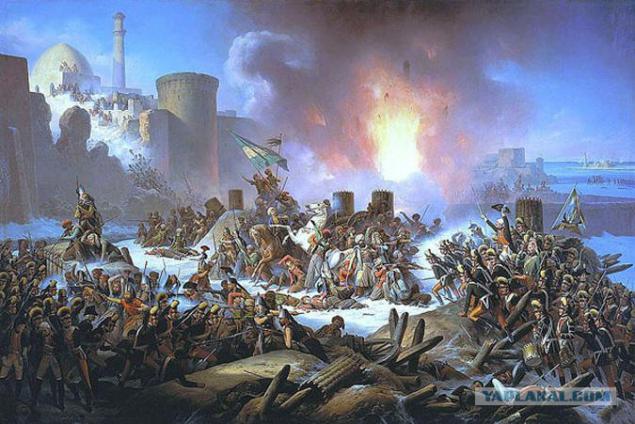1823
As Suvorov trampled Poland
November 4, 1794 by troops under the command of Suvorov was taken Warsaw suburb of Prague, the assault that ended the Polish uprising.

In 1794, General Osip Andreeevich Igelstrёm who commanded Russian troops in Poland, demanded the dissolution of the Polish forces, but Polish general Madalinsky refused to obey, and as a result of sudden attack defeated Russian infantry regiment, then Prussian squadron, and went to Krakow.
Krakow became the center of the Polish uprising, headed by Tadeusz Kosciuszko. 5 (17) April 1794 Warsaw inhabitants rebelled, attacked in the early morning on the fragmented units 8000th Russian garrison. 2200 Russian soldiers were killed in the streets, and the general himself Igelstrёm with several hundred soldiers from different parts of the mansion took up defensive positions in the Russian embassy on Honey Street, but while soldiers defended his residence, he fled in a dress of his mistress Countess Honoratus Zalusskoy dacha Princess Czartoryska .
Suvorov was sent to Poland with 11 thousand soldiers in order to occupy and defend the line of Brest on the Bug River.
Breaking in Brest, Suvorov in September 1794 in several battles in parts defeated a superior body of the Polish general Sierakowski.

Shortly before the Prussian army, which included a detachment of the Russian General Ivan queen failed in the siege of Warsaw, and padding. Troop queens on orders Repnina marched connection with Suvorov. Trying to prevent this, Kosciusko with forces of up to 10 thousand. Went into the battle with the 12 th. Corps queen, was defeated on September 28 (October 10) at Maciejowice wounded and taken prisoner.
In early October, Suvorov made from Bresta.14 October submission Suvorov was given squad queen, his army began to count up to 19 thousand. Soldiers. 15 (26) October on the way to Warsaw at the village vanguard filly Suvorov defeated the 4000th group of rebels from the housing Makranovskogo. October 19 to Suvorov joined Russian squad lieutenant-general Derfelden, after which the number of troops under the command of Suvorov made 24-25 thousand. Soldiers (including 4 tyyachi cavalry and 3000 - Cossacks) with 86 guns.
October 22 Russian troops approached directly to Prague and began to prepare positions for placing artillery batteries.
Prague was connected with Warsaw longest bridge across the Vistula, having a substantial width in this place. The inner line of defense was an earthen wall around Prague. Trunk is that Poles built during the summer, ran more than 6, 5 km and has approximately the shape of a right angle, the short side of which was to the east of the Vistula to the sand hills, then turns more than 90 degrees, and rested against the marshy tributary of the Vistula .
The distance between the inner and outer line of defense was about a kilometer, there is a camp housed Polish troops. The outer line of fortifications (shaft with a triple palisade and ditch) were covered in places advanced bastions and was reinforced by various artificial barriers, including six rows of pitfalls with pointed stakes. At strengthening was established more than 100 pieces, including many heavy. Additional support could provide artillery batteries from the opposite bank of the Vistula.

The disadvantage of Defense Prague was her large extent, the rebels did not have enough manpower to tightly cover the entire line of fortifications. According to reports from sources Suvorov in Warsaw Prague defend to 30 thousand people, but these figures were based on the testimony of prisoners and speculative evaluation. Polish general Vavzhetsky claimed that on the day of the storming of Prague there were up to 10 thousand troops, of which up to 6000 was poorly armed peasant militia, armed with scythes - Kosynierzy. This reading is quite consistent with the loss of Poles, some prisoners have been so much more. In Western literature to assess the amount of 20 thousand involved in the defense of Prague. To weakness of the Polish side should include a semi-anarchist military organization and the efforts of desertion among the rebels.
General Vavzhetsky, who after the capture of the Kosciuszko Polish commander in chief, he decided to leave Prague and concentrate all forces in defense of Warsaw and the left bank of the Vistula River, but did not fulfill the plan.
23 morning (November 3) in October 1794 Suvorov batteries began shelling the fortifications of Prague. In the evening of the same day the order was read to the troops to storm Suvorov:
Walk in silence, without a word; going well for the strengthening quickly rush forward, throwing into the ditch fashinnik, get down, put to the shaft of stairs, and the arrow hit the enemy on the head. Climb briskly, two by two, to defend fellow comrade; if short staircase - a bayonet in the shaft, and climb on it, three times. Without the need not to shoot, and beat and persecute the bayonet; work quickly, bravely, in Russian. Kept his in the middle, from the chiefs to keep up, the front is everywhere. In the house is not running too, begging for mercy - to spare, do not kill unarmed, with the women do not fight, do not touch Maloletkov. Who killed - the kingdom of heaven; alive - glory, glory, glory.
At 5 am 24 (November 4) October before dawn, rocket soared and the first four columns marched in silence on the attack. The further course of the fighting is fully consistent with the disposition of Suvorov. Soldiers covered pitfalls fences and stairs, threw ditch fascines and climbed onto the shaft where bayonets knocked Poles.
One of the leaders of the defense, General Zayonchek, with a bullet in his stomach at the beginning was taken in Warsaw. General Vavzhetsky tried to organize a defense, but after seeing the complete disorder in the Polish army, went over the bridge before 1st column reached him, cutting off retreat defenders Prague. In some areas the Poles have made feeble attempts to counterattack Russian troops between the inner and outer lines of defense, but were immediately overturned. Defence Inland earthworks around Prague crumbled under Russian bayonet attack.

The explosion of ammunition depot in Prague even more intensified panic among the defenders. The bridge was under Russian, Polish side attempts to destroy it by fire artillery suppressed until an order to burn the bridge Suvorov. A small part of the rebels escaped in boats and even less by swimming, successful breakthroughs from Prague through Russian positions were noted.
By 9 am Field battle ended with the extermination of the Polish garrison in Prague. Artillery duel with batteries on the left bank of the Vistula River lasted until 11 am and afternoon resumed only for a moral impact on Warsaw, already shaken by the destruction in the eyes of its inhabitants many thousands of insurgents. After the storming of Prague in the French and British press with the filing of the Polish sources Suvorov became known as bloodthirsty "half-demon", as Napoleon called Suvorov "barbarian, covered in blood Poles».
Suvorov sent officers to inform residents that they fled after the fall of Prague in the Russian camp, which will ensure their safety. Those who followed this appeal, survived.
After successful completion of the storming of Prague Russian soldiers smashing pharmacy brought outside the bottle, try what is in it, and began to drink, praising: glorious, glorious wine each! At that time passed by a veterinarian from horse artillery comes from the Germans. Thinking that ordinary soldiers drink vodka, farrier gulped down a glass of - and then fell off, and a few times and died. It was a spirit! When Suvorov was told about the incident, he said: "At ease, the Germans compete with Russian! Great Russian and German death! »
Suvorov Varshavyane brought the diamond snuff-box with the inscription: "Redeemer Warsaw» («Warszawa zbawcu swemu»). Suvorov himself, even with some surprise, wrote from Warsaw Count Rumyantsev about Poles: "Everything has been forgotten. In conversations appeal as friends and brothers. Germans do not like, we love ».
In 1795, as a result of the last of the three sections of its territory of Poland ceased to exist as a state. It crossed the Lithuanian Russian, Belarusian part and the part of the Ukrainian lands. The root of the Polish lands inhabited by ethnic Poles, were divided between Prussia and Austria. In this case also went to Austria and West Ukraiina and Germans, except Western Poland, Bialystok region inhabited by Belarusians.
Subsequently, the Poles fought against Russia on the side of Napoleon, was put up for a hike one hundred thousand troops (from where ??). However, the campaign against Russia failed, and pursuing the retreating troops of Napoleon, the Russian army occupied at the end of February 1813 nearly all the Grand Duchy of Warsaw. Krakow, Thorne, Czestochowa, Zamosc and Modlin surrendered later. Finally, Poland was annexed to Russia.8 June 1815


In 1794, General Osip Andreeevich Igelstrёm who commanded Russian troops in Poland, demanded the dissolution of the Polish forces, but Polish general Madalinsky refused to obey, and as a result of sudden attack defeated Russian infantry regiment, then Prussian squadron, and went to Krakow.
Krakow became the center of the Polish uprising, headed by Tadeusz Kosciuszko. 5 (17) April 1794 Warsaw inhabitants rebelled, attacked in the early morning on the fragmented units 8000th Russian garrison. 2200 Russian soldiers were killed in the streets, and the general himself Igelstrёm with several hundred soldiers from different parts of the mansion took up defensive positions in the Russian embassy on Honey Street, but while soldiers defended his residence, he fled in a dress of his mistress Countess Honoratus Zalusskoy dacha Princess Czartoryska .
Suvorov was sent to Poland with 11 thousand soldiers in order to occupy and defend the line of Brest on the Bug River.
Breaking in Brest, Suvorov in September 1794 in several battles in parts defeated a superior body of the Polish general Sierakowski.

Shortly before the Prussian army, which included a detachment of the Russian General Ivan queen failed in the siege of Warsaw, and padding. Troop queens on orders Repnina marched connection with Suvorov. Trying to prevent this, Kosciusko with forces of up to 10 thousand. Went into the battle with the 12 th. Corps queen, was defeated on September 28 (October 10) at Maciejowice wounded and taken prisoner.
In early October, Suvorov made from Bresta.14 October submission Suvorov was given squad queen, his army began to count up to 19 thousand. Soldiers. 15 (26) October on the way to Warsaw at the village vanguard filly Suvorov defeated the 4000th group of rebels from the housing Makranovskogo. October 19 to Suvorov joined Russian squad lieutenant-general Derfelden, after which the number of troops under the command of Suvorov made 24-25 thousand. Soldiers (including 4 tyyachi cavalry and 3000 - Cossacks) with 86 guns.
October 22 Russian troops approached directly to Prague and began to prepare positions for placing artillery batteries.
Prague was connected with Warsaw longest bridge across the Vistula, having a substantial width in this place. The inner line of defense was an earthen wall around Prague. Trunk is that Poles built during the summer, ran more than 6, 5 km and has approximately the shape of a right angle, the short side of which was to the east of the Vistula to the sand hills, then turns more than 90 degrees, and rested against the marshy tributary of the Vistula .
The distance between the inner and outer line of defense was about a kilometer, there is a camp housed Polish troops. The outer line of fortifications (shaft with a triple palisade and ditch) were covered in places advanced bastions and was reinforced by various artificial barriers, including six rows of pitfalls with pointed stakes. At strengthening was established more than 100 pieces, including many heavy. Additional support could provide artillery batteries from the opposite bank of the Vistula.

The disadvantage of Defense Prague was her large extent, the rebels did not have enough manpower to tightly cover the entire line of fortifications. According to reports from sources Suvorov in Warsaw Prague defend to 30 thousand people, but these figures were based on the testimony of prisoners and speculative evaluation. Polish general Vavzhetsky claimed that on the day of the storming of Prague there were up to 10 thousand troops, of which up to 6000 was poorly armed peasant militia, armed with scythes - Kosynierzy. This reading is quite consistent with the loss of Poles, some prisoners have been so much more. In Western literature to assess the amount of 20 thousand involved in the defense of Prague. To weakness of the Polish side should include a semi-anarchist military organization and the efforts of desertion among the rebels.
General Vavzhetsky, who after the capture of the Kosciuszko Polish commander in chief, he decided to leave Prague and concentrate all forces in defense of Warsaw and the left bank of the Vistula River, but did not fulfill the plan.
23 morning (November 3) in October 1794 Suvorov batteries began shelling the fortifications of Prague. In the evening of the same day the order was read to the troops to storm Suvorov:
Walk in silence, without a word; going well for the strengthening quickly rush forward, throwing into the ditch fashinnik, get down, put to the shaft of stairs, and the arrow hit the enemy on the head. Climb briskly, two by two, to defend fellow comrade; if short staircase - a bayonet in the shaft, and climb on it, three times. Without the need not to shoot, and beat and persecute the bayonet; work quickly, bravely, in Russian. Kept his in the middle, from the chiefs to keep up, the front is everywhere. In the house is not running too, begging for mercy - to spare, do not kill unarmed, with the women do not fight, do not touch Maloletkov. Who killed - the kingdom of heaven; alive - glory, glory, glory.
At 5 am 24 (November 4) October before dawn, rocket soared and the first four columns marched in silence on the attack. The further course of the fighting is fully consistent with the disposition of Suvorov. Soldiers covered pitfalls fences and stairs, threw ditch fascines and climbed onto the shaft where bayonets knocked Poles.
One of the leaders of the defense, General Zayonchek, with a bullet in his stomach at the beginning was taken in Warsaw. General Vavzhetsky tried to organize a defense, but after seeing the complete disorder in the Polish army, went over the bridge before 1st column reached him, cutting off retreat defenders Prague. In some areas the Poles have made feeble attempts to counterattack Russian troops between the inner and outer lines of defense, but were immediately overturned. Defence Inland earthworks around Prague crumbled under Russian bayonet attack.

The explosion of ammunition depot in Prague even more intensified panic among the defenders. The bridge was under Russian, Polish side attempts to destroy it by fire artillery suppressed until an order to burn the bridge Suvorov. A small part of the rebels escaped in boats and even less by swimming, successful breakthroughs from Prague through Russian positions were noted.
By 9 am Field battle ended with the extermination of the Polish garrison in Prague. Artillery duel with batteries on the left bank of the Vistula River lasted until 11 am and afternoon resumed only for a moral impact on Warsaw, already shaken by the destruction in the eyes of its inhabitants many thousands of insurgents. After the storming of Prague in the French and British press with the filing of the Polish sources Suvorov became known as bloodthirsty "half-demon", as Napoleon called Suvorov "barbarian, covered in blood Poles».
Suvorov sent officers to inform residents that they fled after the fall of Prague in the Russian camp, which will ensure their safety. Those who followed this appeal, survived.
After successful completion of the storming of Prague Russian soldiers smashing pharmacy brought outside the bottle, try what is in it, and began to drink, praising: glorious, glorious wine each! At that time passed by a veterinarian from horse artillery comes from the Germans. Thinking that ordinary soldiers drink vodka, farrier gulped down a glass of - and then fell off, and a few times and died. It was a spirit! When Suvorov was told about the incident, he said: "At ease, the Germans compete with Russian! Great Russian and German death! »
Suvorov Varshavyane brought the diamond snuff-box with the inscription: "Redeemer Warsaw» («Warszawa zbawcu swemu»). Suvorov himself, even with some surprise, wrote from Warsaw Count Rumyantsev about Poles: "Everything has been forgotten. In conversations appeal as friends and brothers. Germans do not like, we love ».
In 1795, as a result of the last of the three sections of its territory of Poland ceased to exist as a state. It crossed the Lithuanian Russian, Belarusian part and the part of the Ukrainian lands. The root of the Polish lands inhabited by ethnic Poles, were divided between Prussia and Austria. In this case also went to Austria and West Ukraiina and Germans, except Western Poland, Bialystok region inhabited by Belarusians.
Subsequently, the Poles fought against Russia on the side of Napoleon, was put up for a hike one hundred thousand troops (from where ??). However, the campaign against Russia failed, and pursuing the retreating troops of Napoleon, the Russian army occupied at the end of February 1813 nearly all the Grand Duchy of Warsaw. Krakow, Thorne, Czestochowa, Zamosc and Modlin surrendered later. Finally, Poland was annexed to Russia.8 June 1815
























